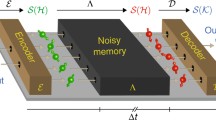Abstract
We study the capacity of a quantum channel where channel acts like controlled phase gate with the control being provided by a one-dimensional quantum spin chain environment. Due to the correlations in the spin chain, we get a quantum channel with memory. We derive formulas for the quantum capacity of this channel when the spin state is a matrix product state. Particularly, we derive exact formulas for the capacity of the quantum memory channel when the environment state is the ground state of the AKLT model and the Majumdar–Ghosh model. We find that the behavior of the capacity for the range of the parameters is analytic.

Similar content being viewed by others
References
Bayat, A., Burgarth, D., Mancini, S., Bose, S.: Memory effects in spin-chain channels for information transmission. Phys. Rev. A 77, 050306 (2008)
Benenti, G., D’Arrigo, A., Falci, G.: Enhancement of transmission rates in quantum memory channels with damping. Phys. Rev. Lett. 103, 020502 (2009)
Kretschmann, D., Werner, R.: Quantum channels with memory. Phys. Rev. A 72, 062323 (2005)
Caruso, F., Giovanetti, V., Lupo, C., Mancini, S.: Quantum channels with memory effects. Rev. Mod. Phys. 86, 1203 (2014)
Plenio, M., Virmani, S.: Spin chains and channels with memory. Phys. Rev. Lett. 99, 120504 (2007)
Plenio, M., Virmani, S.: Many-body physics and the capacity of quantum channels with memory. New J. Phys. 10, 043032 (2008)
Fannes, M., Nachtergaele, B., Werner, R.: Finitely correlated states on quantum spin chains. Commun. Math. Phys. 144–3, 443–490 (1992)
Verstraete, F., Cirac, J.: Valence bond states for quantum computation. Phys. Rev. A 70, 060302(R) (2004)
Orus, R.: A practical introduction to tensor networks: matrix product states and projected entangled pair states. Ann. Phys. 349, 117–121 (2014)
Majumdar, C., Ghosh, D.: On next nearest-neighbour interaction in linear chain. J. Math. Phys. 10, 1388–1402 (1969)
Affleck, A., Kennedy, T., Lieb, E., Tasaki, H.: Valence bond ground states in isotropic quantum antiferromagnets. Commun. Math. Phys. 115, 477–528 (1988)
Deng, X., Porras, D., Cirac, J.: Effective spin quantum phases in systems of trapped ion. Phys. Rev. A 72, 063407 (2005)
Lewenstein, M., Sanpera, A., Ahufinger, V.: Ultracold Atoms in Optical Lattices: Simulating Quantum Many-Body Systems. Oxford University Press, Oxford (2012)
Korepin, V., Ying, X.: Entanglement in valence bond solid states. Int. J. Mod. Phys. B 24(11), 1361–1440 (2010)
Benenti, G., DArrigo, A., Falci, G.: Quantum capacity of dephasing channels with memory. New J. Phys. 9, 310 (2007)
Lemos, G., Benenti, G.: Role of chaos in quantum communication through a dynamical dephasing channel. Phys. Rev. A 81, 062331 (2010)
Arshed, N., Toor, A., Lidar, D.: Channel capacities of an exactly solvable spin-star system. Phys. Rev. A 81, 062353 (2010)
Cover, T., Thomas, J.: Elements of Information Theory. Wiley, Hoboken (2006)
Marchand, K., Mulherkar, J., Nachtergaele, B.: Entropy rate calculations using algebraic measures. In: Proc. IEEE Int. Symp. on Inf. Theory (2012)
Accardi, L., Frigerio, A.: Markovian cocycles. Proc. R. Irish Acad. 83, 251–263 (1983)
Kennedy, T., Tasaki, H.: Hidden symmetry breaking and the Haldane phase in S = 1 quantum spin chains. Commun. Math Phys. 147, 431–484 (1992)
Stephen, D., Wang, D., Prakash, A., Wei, T., Raussendorf, R.: Computational power of symmetry-protected topological phases. Phys. Rev. Lett. 119, 010504 (2017)
Author information
Authors and Affiliations
Corresponding author
A Proof of Lemma 3
A Proof of Lemma 3
The lemma can be easily verified for the cases when \(n=2\), and \(n=3\). So we prove for the case \(n \ge 4\) with \(\{A_1,A_2\}\) as in Eq. (8).
Proof for values
The proof is based on the observation that, for \(n \ge 4\),
Consequently, for \(n \ge 4\),
Now, the nonzero values for \(\text {Tr}(\rho O_1 \cdots O_nO_n^\dagger \cdots O_1^\dagger )\) can be inferred as stated in the lemma. The validity of the observation can be established by mathematical induction on n. For \(n=4\), the observation can be verified explicitly. Now, assuming that the observation is valid for an arbitrary integer \(k \ge 4\), we prove that the observation holds for \(k+1\). Let
By induction hypothesis
So,
Now, since
we get
Proof of multiplicity
Let \(z_n\), \(b_n\), \(c_n(i)\), \(d_n\), \(e_n(i)\), \(f_n\), \(g_n(i)\), and \(h_n\) denote the multiplicity of \(Z_n\), \(B_n\), \(C_n(i)\), \(D_n\), \(E_n(i)\), \(F_n\), \(G_n(i)\), and \(H_n\), respectively, in \(\{ O_1 O_2 \cdots O_n O_n^{\dagger } O_{n-1}^{\dagger } \cdots O_1^{\dagger }: O_i \in \{A_1, A_2\}, 1 \le i \le n\}\). From Eqs. (25)–(34), we obtain the following recurrence relations: For \(n\ge 5\),
with initial conditions
Solving the above recurrences with the given initial conditions results in
Now that we have identified the distinct values along with multiplicities for
we can consider the cases of n being odd or even to conclude the lemma.
Rights and permissions
About this article
Cite this article
Mulherkar, J., Sunitha, V. Capacity of a quantum memory channel correlated by matrix product states. Quantum Inf Process 17, 80 (2018). https://doi.org/10.1007/s11128-018-1847-4
Received:
Accepted:
Published:
DOI: https://doi.org/10.1007/s11128-018-1847-4




